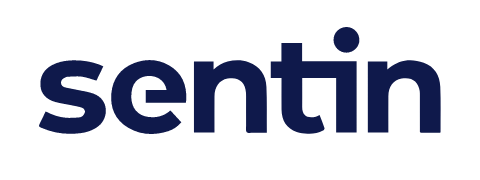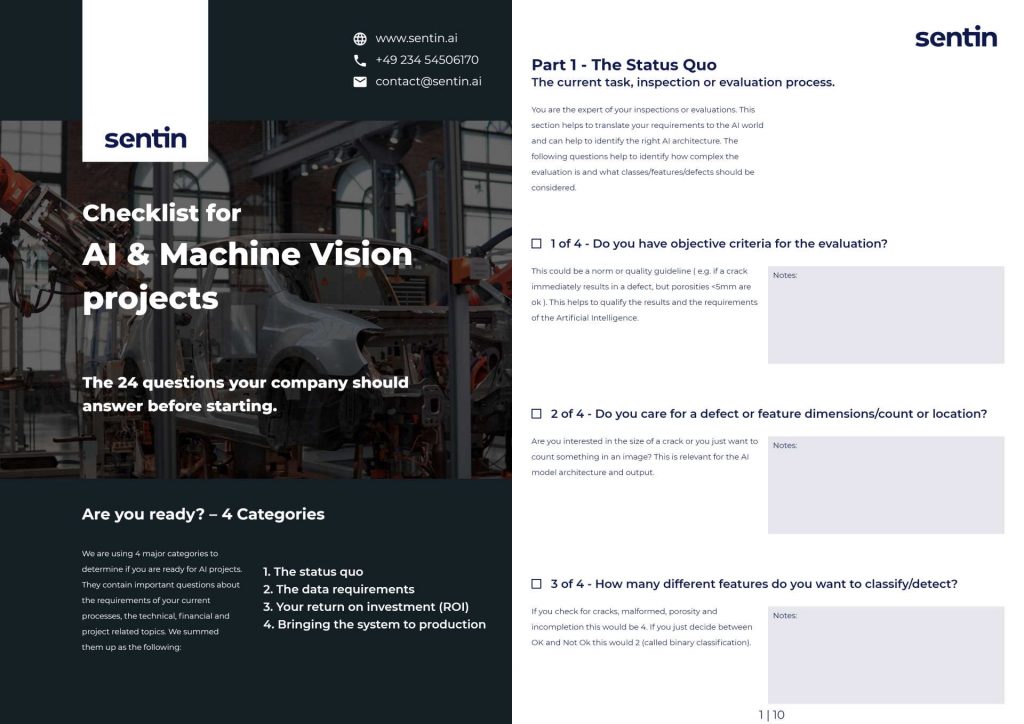FAQ - Questions And Answers
The team of sentin consists of experienced developers and engineers. The focus of the company is the visual and image-based control of materials and products. The knowledge about inspection processes e.g. in quality assurance or non-destructive testing (NDT) and technical details about software development, Deep Learning and industrial image processing (Machine Vision) we have prepared for you here and in our articles.
Free checklist
with 24 questions.
Is your company ready for AI & Machine Vision projects?
Table of Contents
Your solution.
Our Approach.
Dataset Preparation
We prepare your image data together with the sentin EXPLORER and our experts.
Together, we take a look at your use case and decide whether we are the right partner for you.
If your use case is suitable for using the full potential of AI for image analysis, you structure and annotate your data with us.
Goal: a data set optimized for AI.
Adapting Workflows & ModelS
We adapt our AI models & interfaces to your use case.
Your requirements may include specifications regarding error types, evaluation speed or accuracy. We select the appropriate AI models and architectures and train them for you using your data set.
Likewise, interfaces can be adapted (workflows) so that you can make optimal use of the evaluation with sentin EXPLORER.
Goal: A validated AI model for your use case.
Integration
Use the sentin EXPLORER in your production/process environment.
After the necessary adjustments have been made, you can use the sentin EXPLORER in your process/productive environment.
You will receive a license key for the use of all necessary sentin EXPLORER components.
Goal: Your automatic inspection or evaluation system.
Usage, Support & Updates
You benefit from new features, performance updates and first-class support.
Plus, you can recalibrate your models should anything change.
Use the software as long as you need it. You benefit from all the advantages of a Software as a Service solution. Due to the continuous payment model for the license, you receive new features and performance updates as well as first-class support.
Likewise, you can use sentin EXPLORER to adapt your AI models retrospectively if something changes in your process.
Artificial Intelligence & Machine Vision
Basic Knowledge - Artificial Intelligence
What is Computer Vision?
Computer Vision is a science at the interface between computer science and engineering, which enables computers to see and understand digital images.
What is artificial intelligence?
Artificial Intelligence (AI) is the term used to describe programs that can perceive, understand, react and adapt their behavior to the situation. The term is often used as a synonym for Machine or Deep Learning and is seen as a contrast to rule-based programming.
What is Deep Learning?
Deep Learning is a subcategory of Artificial Intelligence and Machine Learning and uses neural networks and large amounts of data to make predictions and own decisions. In so-called training, the system is shown sample data and automatically optimizes itself to maximize recognition accuracy. The models generated from this data can then be used for a use case for evaluation.
What is an AI model?
An AI model can be regarded as an evaluation software. In the case of Deep Learning, it is a so-called network of evaluation functions, which can thus learn arbitrarily complex relationships. The parameters of the evaluation functions, the network architecture and the interface for querying evaluations then represent a model that can be used elsewhere, e.g. in another software or plant.
What is Machine Vision?
The subject area of Machine Vision is the industrial application of Computer Vision for e.g. automation in quality assurance or digital assistance in non-destructive testing.
How does classic machine vision (before 2012) work?
Classical Machine Vision pursues the goal of evaluating image data, but for this purpose it uses fixed, rule-based algorithms that are created by a programmer. Since 2012, algorithms and computers have become so efficient that Deep Learning can be an alternative for too complex error images and the system can learn automatically. More about the Image Net Challenge can be found here.
Why is Deep Learning better than rule-based approaches (after 2012)?
In a dynamic environment, rule-based systems must be continuously readjusted. AI-based software, on the other hand, is flexible and can guarantee very high detection rates even under varying environmental conditions. Furthermore, it can become more and more accurate as training data increases.
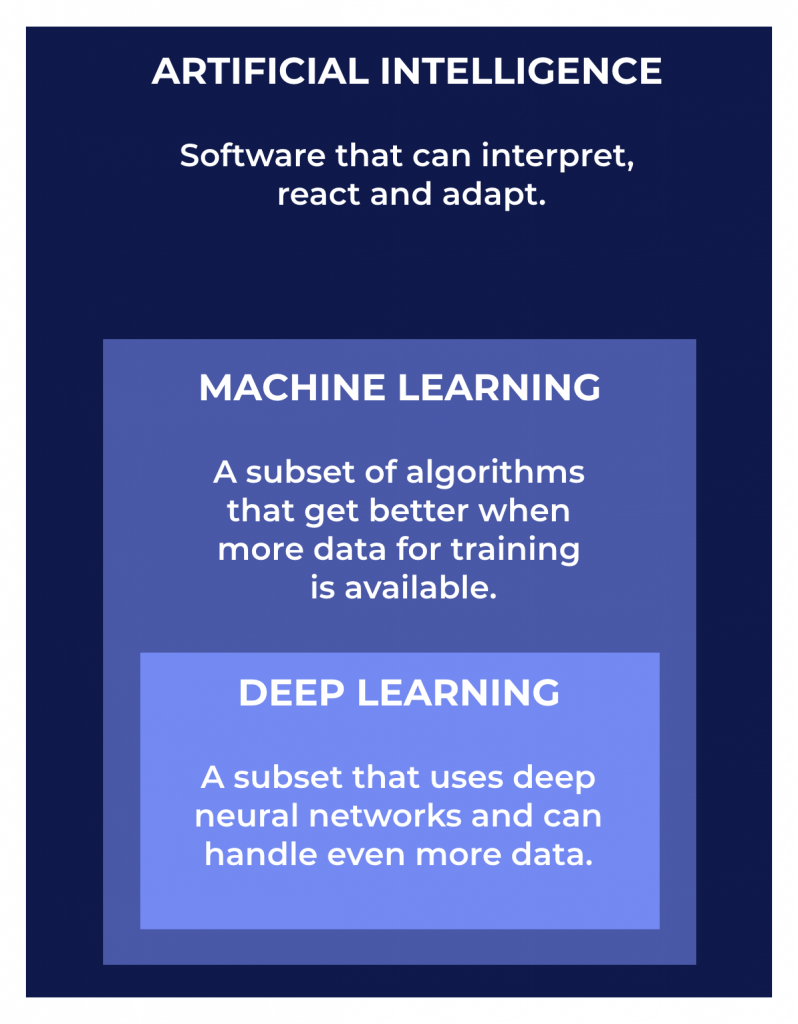
Artificial Intelligence in industry
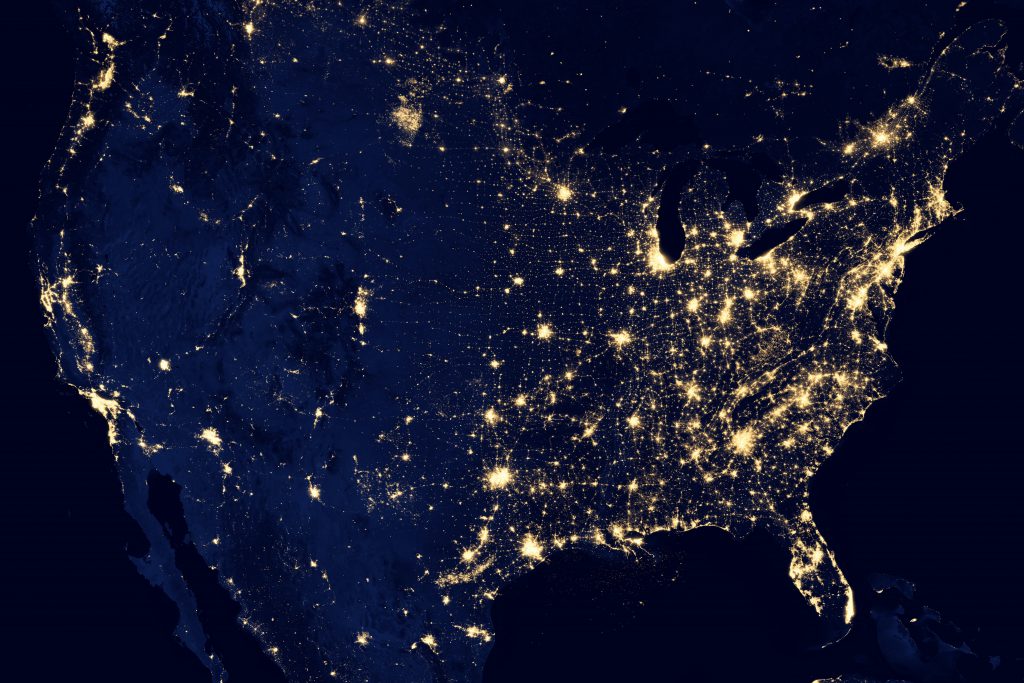
How can Computer Vision and AI support my production?
Image processing using a Deep Learning algorithm is faster than human inspection and more robust than classical rule-based approaches. This results in the following advantages for you:
- Reduction of inspection costs
- More reliable detection
- Shorter cycle times
How many images do I need for the AI?
Depending on the complexity of the use case and the desired accuracy, between 100 and 50,000 images are required for training. To do this, these images must be sorted into defect classes, for example, or the defects must be marked in the image. You can use the sentin EXPLORER for this sorting/marking.
Does the image material for the AI have to have a specific format?
The image data should be stored as loss-free as possible. The most suitable formats are PNG – for images in the normal RGB range – or TIFF – for images with a lot of depth information, e.g. 16-bit accuracy. For annotations we recommend the COCO format or you can use the sentin EXPLORER to convert the data into the correct format under software guidance.
How long does it take to train the AI?
The training of the AI model depends on the application case and the image set. If the optimal hardware is used, this can be done within a few hours. More critical than the training, however, is to clean up the image data or to select the correct training parameters. If these parameters are already known, it is possible to train faster with new images afterwards. Another possibility is the so-called transfer learning. Here, already existing models can be used as starting point for a new model.
Do I need new hardware for AI software?
The existing hardware can usually still be used. Your existing camera hardware can be used to generate the image material. Depending on the complexity of processing, costs for a computing unit may be incurred. We therefore recommend training on a cloud from a cost perspective. Afterwards, an image evaluation can be performed on a local computing unit.
If you would still like to train the solution in your company, you will have to purchase a Machine Learning GPU.
How do I integrate an AI solution into my audit process?
With the help of the sentin EXPLORER you can either export your models and use them in your test hardware or you can use the user interface to process and view your images at the push of a button.
About sentin
Do I have to order sentin for each new use case?
No, sentin gives the user the possibility to train, manage and export the AI himself with the sentin EXPLORER.
Do I need to have sentin recalibrate my models? Am I dependent on sentin?
No. The advantage of Deep Learning models is that it can be improved with new data. With the help of the sentin EXPLORER you can easily import and retrain them yourself. You remain independent.
Can the evaluation be used locally without an Internet connection?
Yes, after a model has been exported, you can use it on a calculation unit. You decide where you want to train and evaluate the models. However, hardware costs may be incurred for local operation. (LINK to top)
What technologies does sentin use?
sentin uses modern technologies to make the evaluation and training as fast and convenient as possible for you. The user interface is mainly based on an Electron application. The management routines and the machine learning algorithms primarily use Python and the frameworks PyTorch and TensorFlow.
What makes sentin different from other computer vision providers?
sentin offers you the possibility to automate your evaluation with software and to manage your AI models. The advantage over rule-based approaches and classical providers is the lower calibration effort, more accurate/robust detection and your independence, e.g. in recalibration.
Compared to other AI software vendors, sentin can use its own models for industrial use cases. Likewise, the ability for you to manage and calibrate your own models is a unique selling point. The customer-oriented approach and the striving for the best possible usability are always in the center of attention.
What does the sentin software cost me?
sentin is a software provider, i.e. you pay us in the form of a license model for a fully developed product.
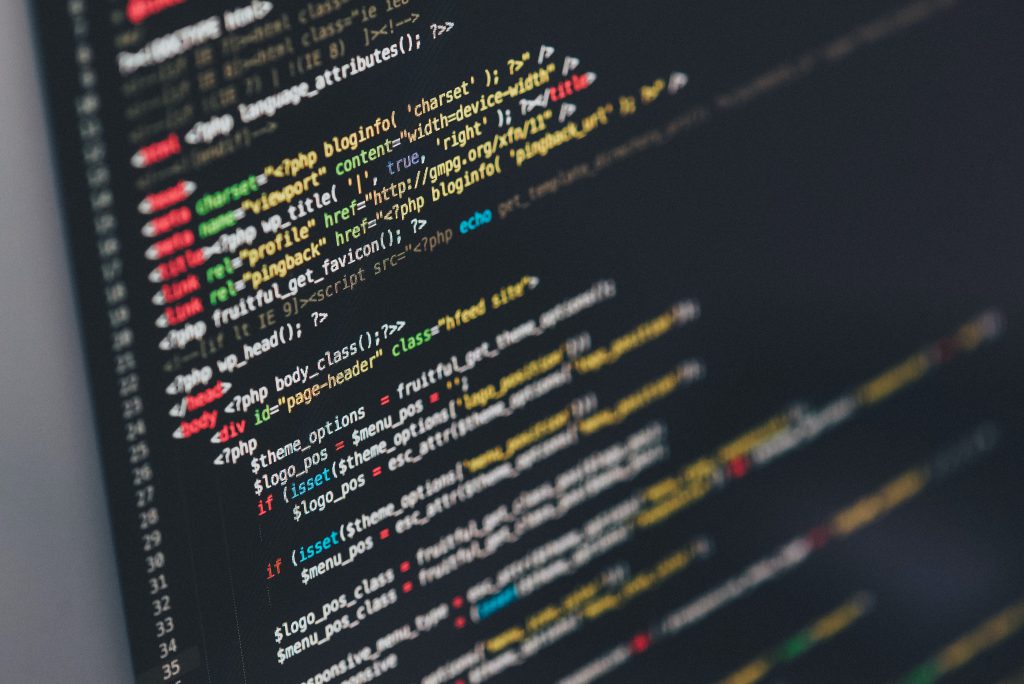
Produktion und Qualitätssicherung
Als Ausschuss bezeichnet man Produkte, die fehlerhaft sind und aussortiert werden. Entsprechen diese jedoch dem Qualitätsstandard und werden fälschlicherweise aussortiert spricht man von Pseudoausschuss. Wenn ein Produkt hingegen nicht dem Standard entspricht, aber nicht aussortiert (also übersehen) wird, nennt man diesen Anteil Schlupf, der häufig zu Reklamationen führt.
Einen Artikel zu Pseudoausschuss und Schlupf gibt es hier.
Die Falschakzeptanzrate (FAR) beschreibt die Häufigkeit, keines Ausschusses, obwohl das Produkt nicht den Qualitätsansprüchen gerecht wird. Also die Häufigkeit von Schlupf.
Die Falschrückweisungsrate (FRR) beschreibt die Häufigkeit, eines Ausschusses, obwohl das Produkt allen Qualitätsansprüchen gerecht wird. Also die Häufigkeit der Pseudoausschüsse.
Einen Artikel über FAR und FRR gibt es hier.
Um Qualitätskontrollen zu automatisieren sind 3 Schritte notwendig.
1. Schritt: Auswahl der Kamera
In diesem Schritt wird untersucht, welche Kamera-Konfiguration sich für einen Anwendungsfall am besten eignet. Diese wird dann für die automatische Qualitätskontrolle verwendet.
2. Schritt: Auswahl der Beleuchtung
Ebenfalls sollten verschiedene Leuchtmittel getestet werden, da meist ohne die richtige Beleuchtung keine aussagekräftigen Bilder erfasst werden können und somit Probleme bei der Auswertung entstehen können.
3. Schritt: Auswahl und Training des KI-Algorithmus
Wichtig für das Training der KI-Modelle ist eine ausreichende Datenbasis und die Auswahl der richtigen KI-Modell Architektur. Häufig lernt das System anhand von weniger als 500 Beispielen, wie etwas auszusehen hat. Je nach Anwendungsfall kann eine Bildaufnahme und Auswertung in wenigen Millisekunden stattfinden.
Mehr Informationen zu den 3 Schritten können Sie hier nachlesen.
Im Qualitätsmanagement werden in allen Bereichen, die sich direkt oder indirekt auf die Kundenzufriedenheit auswirken, versucht, ein hohes Maß an Qualität sicherzustellen.
In der Qualitätssicherung werden ausschließlich potentiell negative Einflüsse auf die Qualität des Endproduktes analysiert und diese dann bestenfalls beseitigt. Somit wird gewährleistet, dass die Vorgaben des Qualitätsmanagements eingehalten und korrekt umgesetzt werden.
Mehr über den Unterschied von Qualitätsmanagement und Qualitätssicherung erfahren Sie hier.
Zerstörungsfreie Prüfung (ZfP)
Die zerstörungsfreie (Werkstoff-) Prüfung (ZfP) ist eineUntersuchung von Bauteilen oder Werkstücken auf ihre Qualität und Struktur, die diese nicht beschädigt oder beeinträchtigt. Sie wird in der internationale Norm DIN EN ISO 9712 geregelt und in diversen industriellen Branchen angewendet wie dem Anlagen-, Maschinen-, Stahl-, Kraftwerks- oder Fahrzeugbau.
Mehr über die Arten der ZfP finden Sie hier.
Die digitalen Radioskopie (DR) ist eine Disziplin der zerstörungsfreien Werkstoffprüfung (ZfP). Mit Hilfe von Röntgenstrahlen werden Bauteile nach Ungänzen untersucht ohne sie zu beschädigen. Auf der anderen Seite des Bauteils befindet sich ein Detektor, welche die Daten zu einem Live-Bild aufbereitet und an einen Monitor übermittelt. Dort können Materialfehler entdeckt und markiert werden.
Die 5 Vorteile von DR können Sie hier sehen.
Die Aufgaben der DGZfP sind sehr vielfältig:
- Veröffentlichung der fünfmal jährlich erscheinenden „ZfP-Zeitung“
- Aus- und Weiterbildung von Prüfpersonal durch Kurse und Prüfungen
- Ausgabe von Kompetenzzertifikaten durch die DGZfP Personalzertifizierung (DPZ)
- Regelmäßige fachliche Weiterbildung in 18 regionalen Arbeitskreisen
- Festlegung von Normen und Richtlinien auf nationaler und internationaler Ebene in den Fachausschüssen
Einen Artikel über die Aufgaben der DGZfP finden Sie hier.
Die ZfP-Zeitung ist eine Fachzeitschrift für ZfP von den drei DACH-Gesellschaften DGZfP, ÖGfZP (Österreich) und SGZP (Schweiz). Sie besteht aus einem Informationsteil, Fachbeiträgen von ZfP-Experten zu aktuellen wissenschaftlichen Problemen, Berichten sowie Neuigkeiten auf dem Gebiet der Ausbildung, Zertifizierung und Normung. In Werbeanzeigen können Mitgliedsfirmen ihr Unternehmen oder ihre neuen Entwicklungen vorstellen.
Mit der ZfP-Zeitung werden fünfmal jährlich mit einer Auflage von fast 4000 Exemplaren ZfP-Experten in fast allen europäischen Ländern erreicht. Die Zeitschrift ist im Mitgliedsbeitrag bereits enthalten und muss nicht noch zusätzlich gezahlt werden.
Die weiteren Aufgaben der DGZfP können Sie hier nachlesen.
What others say about our digital inspectors.
Free checklist
with 24 questions.
Is your company ready for AI & Machine Vision projects?

Dominik Nestler
Business Development
- +49 234 54506170
- contact@sentin.ai
